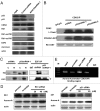p53 negatively regulates Aurora A via both transcriptional and posttranslational regulation
- PMID: 22894933
- PMCID: PMC3466554
- DOI: 10.4161/cc.21732
p53 negatively regulates Aurora A via both transcriptional and posttranslational regulation
Abstract
p53 plays an important role in mitotic checkpoint, but what its role is remains enigmatic. Aurora A is a Ser/Thr kinase involved in correcting progression of mitosis. Here, we show that p53 is a negative regulator for Aurora A. We found that p53 deficiency leads to Aurora A elevation. Ectopic expression of p53 or DNA damage-induced expression of p53 can suppress the expression of Aurora A. Mechanistic studies show that p53 is a negative regulator for Aurora A expression through both transcriptional and posttranslational regulation. p53 knockdown in cancer cells reduces the level of p21, which, in turn, increases the activity of CDK2 followed by induction of Rb1 hyperphosphorylation and its dissociation with transcriptional factor E2F3. E2F3 can bind to Aurora A gene promoter, potentiating Aurora A gene expression and p53 deficiency, enhancing the binding of E2F3 on Aurora A promoter. Also, p53 deficiency leads to decelerating Aurora A's turnover rate, due to the fact that p53 deficiency causes the downregulation of Fbw7α, a component of E3 ligase of Aurora A. Consistently, p53 knockdown-mediated Aurora A elevation is mitigated when Fbw7α is ectopically expressed. Thus, p53-mediated Aurora A degradation requires Fbw7α expression. Significantly, inverse correlation between p53 and Aurora A elevation is translated into the deregulation of centrosome amplification. p53 knockdown leads to high percentages of cells with abnormal amplification of centrosome. These data suggest that p53 is an important negative regulator of Aurora A, and that loss of p53 in many types of cancer could lead to abnormal elevation of Aurora A and dysregulated mitosis, which provides a growth advantage for cancer cells.
Figures






Comment in
-
p53-Aurora A mitotic feedback loop regulates cell cycle progression and genomic stability.Cell Cycle. 2012 Oct 15;11(20):3719-20. doi: 10.4161/cc.22113. Epub 2012 Sep 14. Cell Cycle. 2012. PMID: 22982999 Free PMC article. No abstract available.
Similar articles
-
Identification of Aurora-A as a direct target of E2F3 during G2/M cell cycle progression.J Biol Chem. 2008 Nov 7;283(45):31012-20. doi: 10.1074/jbc.M803547200. Epub 2008 Sep 7. J Biol Chem. 2008. Retraction in: J Biol Chem. 2016 Oct 21;291(43):22842. doi: 10.1074/jbc.A116.803547. PMID: 18776222 Free PMC article. Retracted.
-
FBXW7 is involved in Aurora B degradation.Cell Cycle. 2012 Nov 1;11(21):4059-68. doi: 10.4161/cc.22381. Epub 2012 Oct 24. Cell Cycle. 2012. PMID: 23095493 Free PMC article.
-
CRE-transcription factor decoy oligonucleotide inhibition of MCF-7 breast cancer cells: cross-talk with p53 signaling pathway.Biochemistry. 2000 Apr 25;39(16):4863-8. doi: 10.1021/bi992272o. Biochemistry. 2000. PMID: 10769144
-
Targeting Aurora-2 kinase in cancer.Mol Cancer Ther. 2003 Jun;2(6):589-95. Mol Cancer Ther. 2003. PMID: 12813139 Review.
-
Aurora kinases link chromosome segregation and cell division to cancer susceptibility.Curr Opin Genet Dev. 2004 Feb;14(1):29-36. doi: 10.1016/j.gde.2003.11.006. Curr Opin Genet Dev. 2004. PMID: 15108802 Review.
Cited by
-
Aurora-A mediated phosphorylation of LDHB promotes glycolysis and tumor progression by relieving the substrate-inhibition effect.Nat Commun. 2019 Dec 5;10(1):5566. doi: 10.1038/s41467-019-13485-8. Nat Commun. 2019. PMID: 31804482 Free PMC article.
-
TP53/p53 alterations and Aurora A expression in progressor and non-progressor colectomies from patients with longstanding ulcerative colitis.Int J Mol Med. 2015 Jan;35(1):24-30. doi: 10.3892/ijmm.2014.1974. Epub 2014 Oct 20. Int J Mol Med. 2015. PMID: 25333414 Free PMC article.
-
AURKB promotes bladder cancer progression by deregulating the p53 DNA damage response pathway via MAD2L2.J Transl Med. 2024 Mar 21;22(1):295. doi: 10.1186/s12967-024-05099-6. J Transl Med. 2024. PMID: 38515112 Free PMC article.
-
Aurora B prevents delayed DNA replication and premature mitotic exit by repressing p21(Cip1).Cell Cycle. 2013 Apr 1;12(7):1030-41. doi: 10.4161/cc.24004. Epub 2013 Feb 21. Cell Cycle. 2013. PMID: 23428904 Free PMC article.
-
From Crypts to Cancer: A Holistic Perspective on Colorectal Carcinogenesis and Therapeutic Strategies.Int J Mol Sci. 2024 Aug 30;25(17):9463. doi: 10.3390/ijms25179463. Int J Mol Sci. 2024. PMID: 39273409 Free PMC article. Review.
References
Publication types
MeSH terms
Substances
Grants and funding
LinkOut - more resources
Full Text Sources
Research Materials
Miscellaneous
